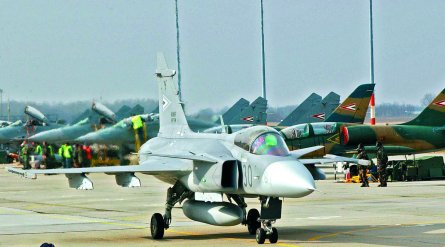Swedes lobby Norway and Denmark to join Saab JAS39 industrial programme as discontent with F-35 grows
Gripen International has proposed a common Nordic industrial programme for further development of the Swedish Saab JAS39 fighter as the centrepiece of its responses to tender requests from Denmark and Norway. Both countries are conducting formal competitions in the lead-up to decisions later this year on whether to commit to procurement of the Lockheed Martin F-35 Joint Strike Fighter or acquire alternative aircraft.
Norway is a key battleground for Lockheed as it tries to keep all eight international participants in JSF system development and demonstration (SDD) on board for the production, sustainment and follow-on development (PSFD) phase. Norwegian industry discontent with their participation has fuelled political opposition to the JSF.
|
Hungary last week became the second Gripen export operator |
The “Nordic solution” proposed by Gripen International would involve direct industrial participation by Denmark and Norway in ongoing spiral development of the JAS39, said senior vice-president for international sales Bob Kemp at last week’s FIDAE show in Chile. The Norwegian tender response “makes it very clear to them it is a Nordic approach”, he says.
Lockheed has responded to Denmark’s request for information (RFI) and is responding to Norway’s in two phases, says F-35 programme general manager Tom Burbage. “We have submitted the industrial participation and cost sections. The technical element will be delivered by the end of the month.”
Norway is due to make its next SDD payment on 1 June, but requested and received a waiver of the contractual requirement to provide 90 days notice of withdrawal from the JSF programme. Burbage says the move is tied to government-to-government negotiations over the PSFD phase and has “nothing to do with the RFI”.
The Gripen bid offers Norway’s industry a role in evolving the communications and data transfer systems and developing an intelligence, surveillance and reconnaissance role for the aircraft. Co-operation on derivatives of Kongsberg’s next-generation anti-ship missile for Gripen is also proposed. Opportunities for Denmark include work for Terma on evolution of the Gripen’s electronic warfare and sensor capabilities.
About half the F-35 industrial package on offer to Norway involves strategic sourcing, but requires competitive pricing. The rest the industry must compete for, Burbage says. JSF work available to Konsgberg includes second sourcing of composite structures, and the Norwegian company is competing to supply conventional edges, he says.
If Oslo withdraws from SDD it would lose its representation in the JSF programme office and forfeit its delivery positions, Burbage says. Norway would go to the back of the production queue and have to buy F-35s through the US foreign military sales system if it later decided it wanted the JSF.
PETER LA FRANCHI / SANTIAGO & GRAHAM WARWICK / WASHINGTON DC
Source: Flight International
























